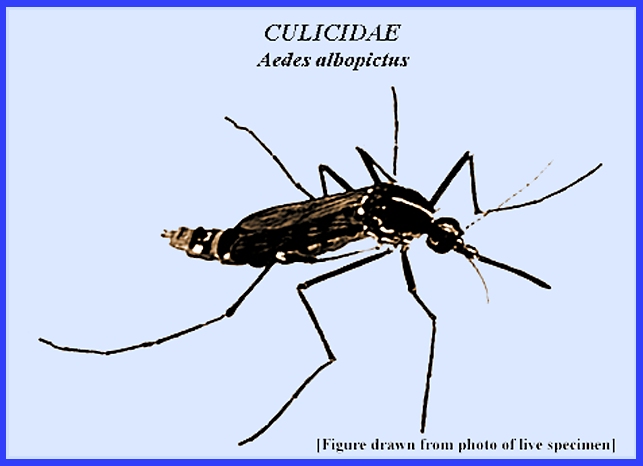File: <dengue.htm> <General Index> Site Description Glossary <Navigate
to Home>
|
DENGUE FEVER (Contact) Please
CLICK on
underlined links for details:
Dengue as haemorrhagic fever (= involves
bleeding in internal organs) is especially lethal to very young
children. According to Service (2005)
dengue type 4 was found in Cuba in 1981, but was followed by reports from
over 26 other countries soon after.
The haemorrhagic type was then found to occur in 18 countries. However, in 1965 there was an outbreak of
dengue in Puerto Rico where some people of African heritage had to remain
bed-ridden for over 4 months. Which
type that caused that severe response is not known. Dengue has since
been considered the most important viral disease transmitted by mosquitoes
(Service 2008) as its occurrence has steadily increased. In the Americas transmission is by Aedes aegypti while in
Southeast Asia also by Aedes albopictus
and Aedes scutellaris. It remains to be seen if the newly arrived
Zika virus disease in America
will equal or overpass Dengue
as the most important viral disease where mosquitoes are involved. Humans serve as principal reservoirs for
the virus in most areas. The vector
mosquitoes all breed in natural and human-made container habitats, where
quiet water persists. Although there
are reports of Dengue in the
wild Simian populations of Asia no epidemics have been associated with them
as reservoir hosts. It is believed
that all epidemics of Dengue
are directly from mosquitoes to humans, which are the reservoir hosts. = = = = = = = = = = = =
= = = = = = = = Key References: <medvet.ref.htm> <Hexapoda> Diallo, M., Y. Ba & A. A. Sall. 2003. Amplification of the sylvatic cycle of dengue virus type 2,
Senegal. 1999-2000: entomologica findings and entomologic considerations. Emerg. Infect. Diseases 9: 362-7. Gratz, N. 2006.
Vector and Rodent-borne Diseases in Europe and North America. Cambridge Univ. Press, England Gratz, N. & A.
B. Knudsen. 1996. The Rise & Spread of Dengue, Dengue
Haemorrhagic Fever & its Vectors:
Historical Rev. to 1995. WHO
96.7. Gubler, D. J. & G.
Kuno. 1997. Dengue & Dengue Haemorrhagic Fever. CAB International, Wallingford. Halstead, S. B. & H. Gomez-Dantes. 1992.
Eengue: A world-wide Problem,
A Common Strategy. Proc. Intern.
Conf. on Dengue & Aedes aegypti
communily-based control. Mexico:
Min. of Health, Rockefeller Found. Legner, E.
F.
1995. Biological
control of Diptera of medical and veterinary importance. J. Vector Ecology 20(1): 59_120. Matheson, R. 1950. Medical Entomology. Comstock Publ. Co, Inc. 610 p. Mutebi, J. P. &
A. D. T. Barrett. 2002. The epidemiology of yellow fever in
Africa. Microbes & Infections
4: 1459-68. Service, M. 2008.
Medical Entomology For Students.
Cambridge Univ. Press. 289 p Tomori, O. 1999.
Impact of yellow fever on the developing world. Adv. in Virus Res. 53: 5-34. World Health
Organization. 1997. Dengue Haemorrhagic Fever: Diagnosis, Treatment, Prevention &
Control. WHO 2nd. edn., Geneva. |
